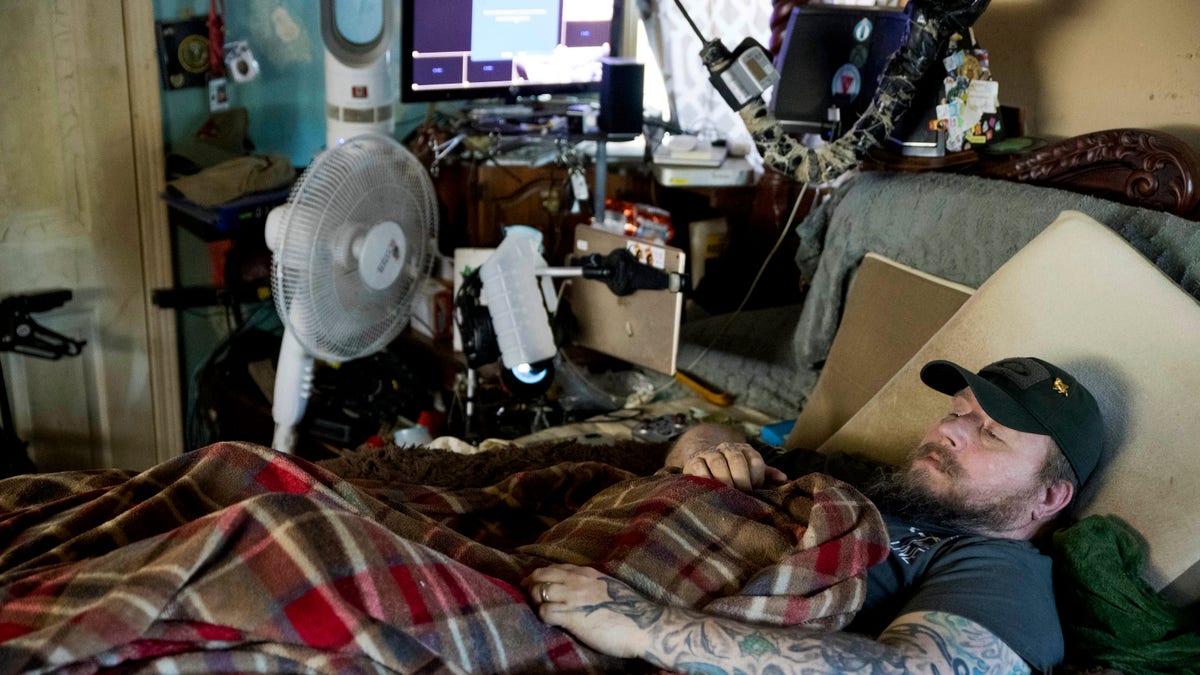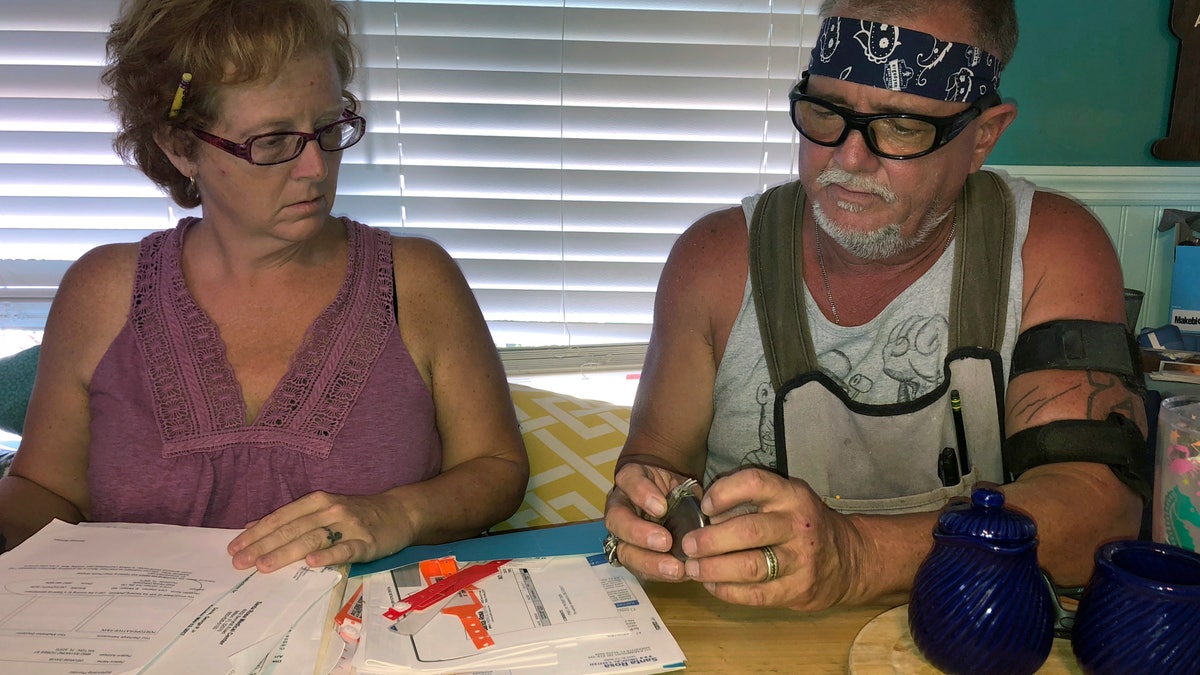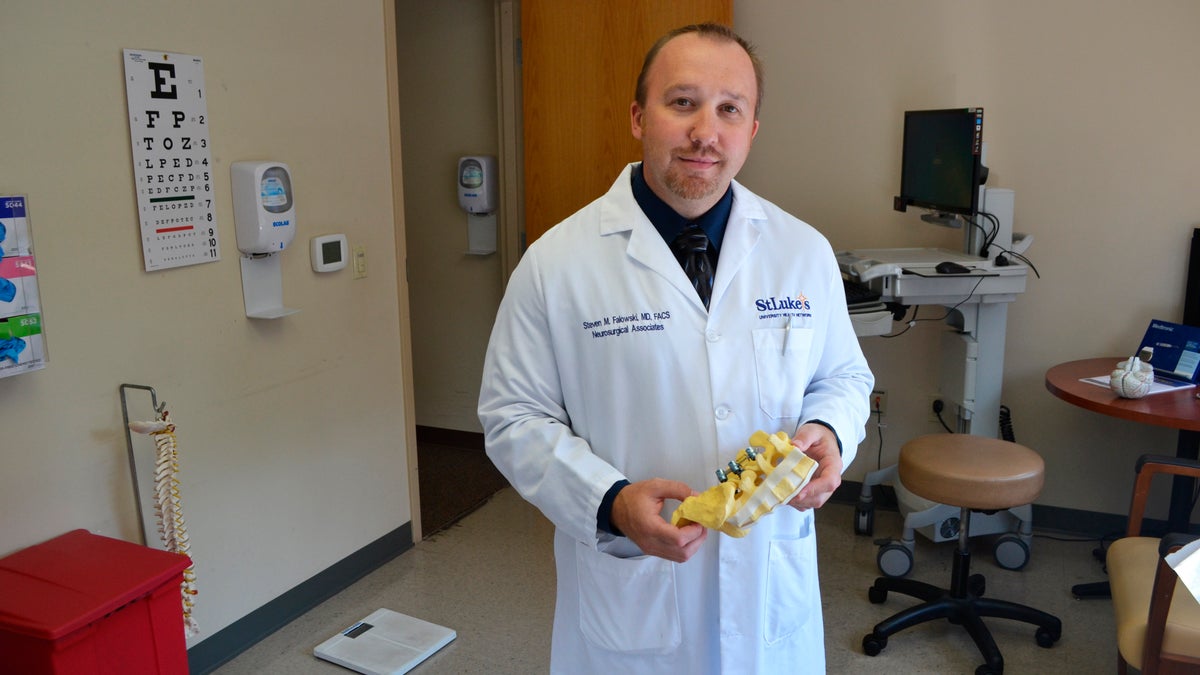
Jim Taft has experienced debilitating health issues after a neurosurgeon implanted Boston Scientific's Precision spinal cord stimulator in his back in 2014. (AP)
Desperate for relief after years of agony, Jim Taft listened intently as his pain management doctor described a medical device that could change his life.
It wouldn't fix the nerve damage in his mangled right arm, Taft and his wife recalled the doctor saying, but a spinal-cord stimulator would cloak his pain, making him "good as new."
Taft's stimulator failed soon after it was surgically implanted. After an operation to repair it, he said, the device shocked him so many times that he couldn't sleep and even fell down a flight of stairs. Today, the 45-year-old Taft is virtually paralyzed, a prisoner in his own bed, barely able to get to the bathroom by himself.
"I thought I would have a wonderful life," Taft said. "But look at me."
PARALYZED BRIDE WALKS DOWN AISLE 3 YEARS AFTER HORRIFIC ACCIDENT
For years, medical device companies and doctors have touted spinal-cord stimulators as a panacea for millions of patients suffering from a wide range of pain disorders, making them one of the fastest-growing products in the $400 billion medical device industry. Companies and doctors aggressively push them as a safe antidote to the deadly opioid crisis in the U.S. and as a treatment for an aging population in need of chronic pain relief.
But the stimulators — devices that use electrical currents to block pain signals before they reach the brain — are more dangerous than many patients know, an Associated Press investigation found. They account for the third-highest number of medical device injury reports to the U.S. Food and Drug Administration, with more than 80,000 incidents flagged since 2008.

This combination of photos shows demonstration models of implantable neurostimulators, top row from left, the Medtronic Intellis and the Boston Scientific Spectra WaveWriter SCS. Bottom row from left are the Abbott/St. Jude's Proclaim 7 Implantable Pulse Generator and Proclaim DRG Implantable Pulse Generator. (AP)
Patients report that they have been shocked or burned or have suffered spinal-cord nerve damage ranging from muscle weakness to paraplegia, FDA data shows. Among the 4,000 types of devices tracked by the FDA, only metal hip replacements and insulin pumps have logged more injury reports.
The FDA data contains more than 500 reports of people with spinal-cord stimulators who died, but details are scant, making it difficult to determine if the deaths were related to the stimulator or implant surgery.
Medical device manufacturers insist spinal-cord stimulators are safe — some 60,000 are implanted annually — and doctors who specialize in these surgeries say they have helped reduce pain for many of their patients.
BABY WHO HAD SPINE SURGERY IN WOMB THRIVING AFTER BIRTH
Most of these devices have been approved by the FDA with little clinical testing, however, and the agency's data shows that spinal-cord stimulators have a disproportionately higher number of injuries compared to hip implants, which are far more plentiful.
The AP reported on spinal stimulators as part of a nearly yearlong joint investigation of the global medical devices industry that included NBC, the International Consortium of Investigative Journalists and more than 50 other media partners around the world. Reporters collected and analyzed millions of medical records, recall notices and other product safety warnings, in addition to interviewing doctors, patients, researchers and company whistleblowers.
The media partners found that, across all types of medical devices, more than 1.7 million injuries and nearly 83,000 deaths were reported to the FDA over the last decade.

George Davis had three Medtronic spinal-cord implants between 2003 and 2007 after a car accident mangled his back. They temporarily reduced some of his pain, but he said the non-rechargeable batteries that were supposed to last for years never did and he tired of multiple surgical removals. (AP)
The investigation also found that the FDA — considered by other countries to be the gold standard in medical device oversight — puts people at risk by pushing devices through an abbreviated approval process, then responds slowly when it comes to forcing companies to correct sometimes life-threatening products.
Devices are rarely pulled from the market, even when major problems emerge. And the FDA does not disclose how many devices are implanted in the U.S. each year — critical information that could be used to calculate success and failure rates.
The FDA acknowledges its data has limitations, including mistakes, omissions and under-reporting that can make it difficult to determine whether a device directly caused an injury or death. But it rejects any suggestion of failed oversight.
"There are over 190,000 different devices on the U.S. market. We approve or clear about a dozen new or modified devices every single business day," Dr. Jeffrey Shuren, the FDA's medical device director said at an industry conference in May. "The few devices that get attention at any time in the press is fewer than the devices we may put on the market in a single business day. That to me doesn't say that the system is failing. It's remarkable that the system is working as it does."
In response to reporters' questions, the FDA said last week that it was taking new action to create "a more robust medical device safety net for patients through better data." ''Unfortunately, the FDA cannot always know the full extent of the benefits and risks of a device before it reaches the market," the agency said. In the last 50 years, the medical device industry has revolutionized treatment for some of the deadliest scourges of modern medicine, introducing devices to treat or diagnose heart disease, cancer and diabetes.
Pete Corby, who injured his back working as a movie stuntman, said a spinal-cord stimulator helped him deal with his constant pain and stop using the opioids he'd become dependent on.

Dr. Steven Falowski said if spinal cord stimulators are used early enough for pain, they can prevent people from going on opium-based pain killers. (AP)
"This is the greatest thing that saved my life, literally saved my life," said Corby, estimating that up to three-quarters of his original pain was alleviated by the stimulator.
Medical device companies have "invested countless resources — both capital and human — in developing leading-edge compliance programs," said Janet Trunzo, head of technology and regulatory affairs for AdvaMed, the industry's main trade association.
At the same time, medical device makers also have spent billions to try to influence regulators, hospitals and doctors.
In the U.S., where drug and device manufacturers are required to disclose payments to physicians, the 10 largest medical device companies paid nearly $600 million to doctors or their hospitals last year to cover consulting fees, research and travel and entertainment expenses, according to an AP and ICIJ analysis of data from the Centers for Medicare & Medicaid Services. This figure doesn't include payments from device manufacturers like Johnson & Johnson and Allergan, which also sell other products.
On top of that, lobbying records show that the top four spinal-cord stimulator manufacturers have spent more than $22 million combined since 2017 to try to influence legislation benefiting their overall business, which includes other devices.
Some companies have been fined for bribing physicians, illegally promoting products for unapproved uses and paying for studies that proclaim the safety and effectiveness of their products, according to the joint investigation.
In a 2016 case, Olympus Corp. of the Americas, the largest U.S. distributor of endoscopes and related medical equipment, agreed to pay $623.2 million "to resolve criminal charges and civil claims relating to a scheme to pay kickbacks to doctors and hospitals," according to the U.S. Justice Department. Olympus said that it "agreed to make various improvements to its compliance program."
In a case the previous year involving spinal-cord stimulators, Medtronic Inc. agreed to pay $2.8 million to settle Justice Department claims that the company had harmed patients and defrauded federal health care programs by providing physicians "powerful" financial inducements that turned them into "salesmen" for costly procedures. Medtronic denied wrongdoing. "As a matter of policy, Medtronic does not comment on specific litigation," the company said in a statement. "We do stand behind the safety and efficacy of our Spinal Cord Stimulators and the strong benefits this technology provides to patients, many of whom have tried all other therapy options to no benefit."
Some doctors enthusiastically promote spinal-cord stimulators without disclosing to patients they've received money from medical device manufacturers. Some experts say doctors are not legally required to disclose such payments, but they have an ethical obligation to do so. Sometimes the money goes to the doctors' hospitals, and not directly to them.
As for Taft, he said he just wanted to get better, but he has lost hope.
"This is my death sentence," Taft said, stretched out beneath his bed's wooden headboard on which he's carved the words "death row."
"I'll die here," he said.




















